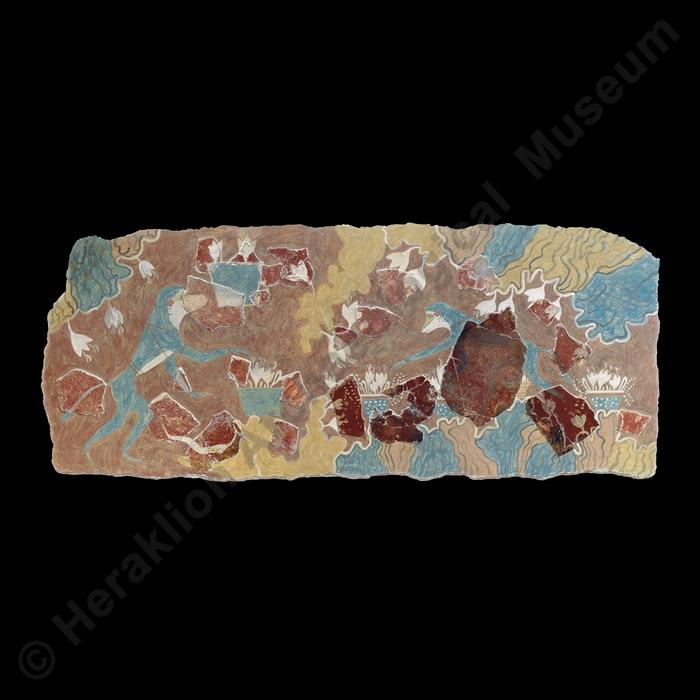Saffron Gatherer Fresco
Τ32Α
Plaster
Reconstruction: E. Gilliéron, P. de Jong (Evans's reconstruction), Th. Fanourakis (Platon's reconstruction)
53 Χ 107 cm.
Knossos
East Wing of the palace
Middle-Late Bronze Age, Neopalatial period. Middle Minoan ΙΙΙΒ – Late Minoan ΙΑ period:
1650-1500 BC:
Gallery:
XIIICase:
144Exhibition thematic unit:
Minoan wall paintingsThe world of nature
Description
One of the earliest examples of pictorial fresco painting at the palace of Knossos is the Saffron Gatherer Fresco, depicting a monkey picking crocus flowers. The painting forms part of a larger saffron-gathering scene that probably adorned the upper frieze of a room on the northeast side of the palace. The scene depicts a rocky landscape with crocuses and a blue figure whose head has not been preserved, picking the flowers and placing them in baskets. Arthur Evans thought that the figure was a boy, so in the first reconstruction of the fresco it was given a child’s head. Gilliéron omitted a small fragment with a small part of an animal’s tail, and did not realise that blue is not used in Minoan painting to represent human skin. However, even in Evans’s time, similarities to the blue monkeys of the “House of the Frescoes” were pointed out, and the figure was restored as a saffron-gathering monkey, as it is displayed in the Heraklion Archaeological Museum today. In the fresco, the rocky outcrops are not only arranged horizontally, on the ground under the monkey, but also above it, giving the impression of a cave with stalactites and stalagmites. The naturalistically painted crocuses, too, not only grow from the ground but also hang down from above, indicating either an artistic convention depicting the mouth of a cave or a surrealist attempt by the artist to depict three-dimensional space. It is probable, as in the Theran fresco, that crocus-gathering is associated with religious beliefs, specifically the offering of saffron to the goddess.Bibliography:
N. Platon, "Συμβολή εις την σπουδήν της Μινωικής Τοιχογραφίας. Ο κροκοσυλλέκτης πίθηκος'', Κρητικά Χρονικά 1, 1947, 506-24. Α. Evans, The Palace of Minos: A comparative account of the successive stages of the early Cretan civilization as illustrated by the discoveries at Knossos, Vol. Ι, 265. Cameron, M.A.S. 1974. A general study of Minoan frescoes with particular reference to unpublished wall paintings from Knossos. Ph.D. diss., University of Newcastle upon Tyne, Volume III: The plates, 84-85. Immerwahr, S.A. 1990. Aegean painting in the Bronze Age. University Park: Pennsylvania State University Press, 41, 170. Shapland, A. 2009. Over the Horizon: Human- Animal Relations in Bronze Age Crete. Ph.D. Diss. University College London, 188. Haysom, M. 2018. "The Find Contexts of Knossian Relief Wall Paintings: Some Ramifications". In Tracing Technoscapes, edited by J. Becker, J. Jungfleisch and C. Von Rüden. 253-278. Lei-den: Sidestone Press, 255.Author:
K. A.Photographs' metadata
